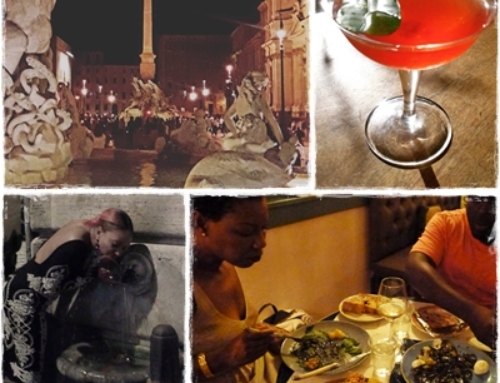
‘All roads lead to Rome’ is a refrain constantly repeated in my mind whenever I am away from Rome. It is a gorgeous, modern city that seems only one step removed from its ancient roots; filled with high-spirited people who celebrate life with their laid back Mediterranean style. The iconic ruins, masterful art and distinctive architecture fascinate me like no other city, but it is the delicious cuisine that touches my soul. I am always dreaming of simple plates of pasta with fresh herbs and sauces prepared using centuries-old recipes. This is my love letter to all cuisine Roman.
La Città Eterna (The Eternal City) is an accurate moniker for a city more than 2,700 years old. The feeling of antiquity is pervasive as you walk through cobble stoned alleyways gazing at buildings that have stood longer than some countries. This sense of history and tradition also permeates the cuisine of the city.
The first time that I walked into the old world style dining room of Cesare, one of the few great restaurants in the vicinity of the Vatican, I knew that it would become a tradition for me. It is the kind of restaurant that Romans grow up in: accompanying their parents as a child, having their very first date, and later bringing their own children there. The menu never changes, except maybe seasonally, and the food is always superb. In our rapidly changing world, it remains a place to come home to.
At the entrance are tanks filled with all manner of live ‘frutti di mare’ – this is a restaurant that takes seafood seriously. I always like to begin with a plate of marinated anchovies that I eat with the hearty bread or a heaping bowl of vongole, small tender clams, in a white wine sauce. As is the case with most traditional restaurants in Italy, the menu is extensive. Besides the fresh seafood, meat is lovingly prepared and there are fantastic thin, crisp pizzas.
Trastevere, bounded on one side by the Tevere (Tiber) river, is one of the oldest neighbourhoods of Rome. In ancient Rome it was inhabited first by the Syrians and later by the Jewish community. Their influence is an integral part of what is considered Roman cuisine; the most ubiquitous dish being carciofi alla giudia, sautéed artichokes which almost every humble cucina and upscale ristorante serve.
In recent history, Trastevere has been an area where artists and bohemiansgravitated, but today it is a definite destination in the evening for Romans and tourists alike. Paris, a wonderful Roman/Jewish restaurant, is located here in a 600 year old building. One of the delicious specialties of the house is ‘fritto vegetale’, a platter of deep-fried, ultra fresh vegetables with fried zucchini blossoms stuffed with mozzarella and anchovies as it’s crowning glory.
One of the oldest established restaurants in Rome, located across from the former site of a slaughterhouse, is Checchino dal 1887. It was originally founded to feed the slaughterhouse workers an inexpensive hearty meal. The menu still features simple fare, such as coda alla vaccinara (oxtail stew) and trippa(tripe), but also showcases grilled meats, pastas and salads.
Trimani, a stylish, yet casual, enoteca (wine bar and restaurant) in the vicinity of the Termini train station, is one of my favourite places for sampling rich Italian cheeses, salami and prosciutto alongside an extensive list of wines by the glass. I always begin by indulging my hedonistic appetite for the Italian sparkling wine, Franciacorta, and then move on to a fantastic Barbaresco or Barolo. Next door to the enoteca is the Trimani wine store, established in 1827, with an impressive selection of mainly Italian vintages that number in the thousands.
Roman style pizza is a very different species from the international snack that is called pizza. There are strict rules about pizza-making: the crust must be thin and it must be made in a ‘forno a legna’, a wood-burning oven. Da Giggetto, in the Porto Piaarea, adheres to these rules and tops their creations with the freshest ingredients. There are numerous offerings to choose from, but the classic Margherita, with tomato sauce and mozzarella, is still the most delicious choice. I don’t always bother with wine when eating pizza; an Italian beer like Birra Moretti is also a good companion.
Within a scene filled with traditional dining, chic international restaurants do find an audience with the fashionable set. On the rooftop of the Cavalieri Hilton there is La Pergola, whose menu is a modern flourish on Mediterranean cuisine. In the nightlife area of Testaccio, you can find Ketumbar, an homage to all things Eastern with it’s Malay name, Balinese décor and Pan Asian menu. Dal Bolognese, overlooking the Piazza del Popolo, is a haunt for the city’s movers and shakers who have a yen for expertly prepared Bolognese cuisine.
Dining in Rome heightens your appreciation of simple fare that has been elevated to sublime. I may have left my heart in New York, but it is certain that my stomach and through that, my soul, resides in Rome.






